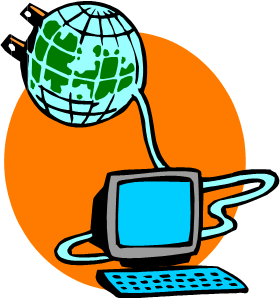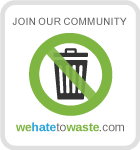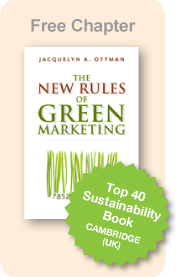Jacquie Ottman's
Green Marketing Blog
Creating the Virtuous Cycle: Integrating Online and Offline Green Marketing
July 20, 2010 by Jacquelyn Ottman
This is a guest blog post by Paul Hannam.
 Conscious consumers are shifting to the web even more rapidly than many other market segments. According to a report in early 2010 from Burst Media, the internet is the number one source of product information for green consumers. Almost 40% of this group prefers the web in contrast to the TV, in second place, at only 18%. All businesses and organizations that want to engage with these consumers need to have a strong online presence.
Conscious consumers are shifting to the web even more rapidly than many other market segments. According to a report in early 2010 from Burst Media, the internet is the number one source of product information for green consumers. Almost 40% of this group prefers the web in contrast to the TV, in second place, at only 18%. All businesses and organizations that want to engage with these consumers need to have a strong online presence.
Marketing professionals are quickly adapting to this significant shift towards “online marketing” by getting up to speed on Pay per Click (PPC) Advertising, Video, Social Media and Mobile, and preparing for general decline in traditional “offline” marketing such as Direct Mail, Newspaper and TV Ads. A recent forecast from E Marketer highlights this transition and predicts a nearly 11% growth in online advertising during 2010, while a Forrester Research study predicts that interactive marketing budgets, as a share of overall budgets, will increase from 13 to 21% by 2014.
An Online-Offline Balancing Act
This long term shift to online marketing traces to many factors including lower cost, more focused targeting, and more predictable ROI. With PPC advertising, for examples, you can affordably set up an advertising campaign on Monday, test it with your target market on Tuesday, evaluate the results on Wednesday, re-launch an “optimized” version on Thursday, and scale up your campaign on Friday. In terms of tracking, measuring and fine-tuning nothing comes close to interactive online marketing.
On the other hand, this does not mean that offline marketing is dead. Indeed most successful green brands would never have reached their intended base of mass consumers without traditional media. Think of Clorox Green Works for example and how their availability in retail outlets like Wal-Mart and Walgreens have led to more sales than the best online green direct marketing campaign could ever do. Moreover, green marketing is also oriented towards local and community promotion like locally-owned stores and Farmers Markets.
So, for mass market green brands, balance is key. Green marketing professionals need to integrate both online and offline media, and establish a “virtuous cycle” where they both enhance each other. This means creating a sales and marketing process that takes advantage of the best that each medium can offer.
Multiple Touch Points
In many ways, the different marketing channels are already merging and overlapping. Consumers see TV commercials on their laptops and listen to radio ads on their iPhones. TV and radio ads direct listeners to websites for special offers, so the best marketing campaigns use multiple touch points including print, website, social media, telemarketing and mobile.
Leverage the Strength of each Green Marketing Mechanism
Each online and offline tool has its own strengths in the overall marketing process. TV is ideal for reaching a mass audience while Social Media with its unprecedented openness and authenticity represents powerful way for engaging influentials in a two-way conversation. Consider how Patagonia’s Facebook Fan Page starts a conversation with discriminating greens by laying out the honest facts about everything that is good and bad about their products.
One of my favorite examples of successful online and offline integration is Method, the upstart green cleaning and personal care products company. As described in Jacquie Ottman’s upcoming book, The New Rules of Green Marketing, they managed to secure in over 25,000 retail outlets including Target and Whole Foods purely on the strength of offline marketing.
Their Methodhome.com website, for instance, features their engaging People Against Dirty Campaign that fully leverages the power of social marketing, complete with Facebook-style photos of campaign “advocates” who participate in the mission to promote green cleaning, while interacting with other advocates through their Facebook, Twitter and Flickr communities.
To further stack up against major players like Procter & Gamble, Method is now using paid media to introduce their revolutionary spray-pump laundry detergent. Commercials on YouTube gain additional exposure and media buzz. Meanwhile, “Cleaning Tours” in Chicago, Boston, New York and other cities generate trial and reinforce the company’s offbeat style by setting up “pop-up shops” on street corners where customers can swap an old toxic cleaning product for a free Method one.
Action Steps for Onlne and Offline Marketing Integration
So consider how you can do the same in your organization and boost the impact of your green marketing. Start by setting up (and even linking—the subject of a future article) a Facebook Page, Twitter and YouTube or other social media account and connect them to your website so you have more online points of contact with your consumers.
Use Facebook for dialogue, Twitter for Tweets and YouTube to showcase your products and offline commercials. To boost your online presence, ensure your Website, Facebook and Twitter addresses are on all your marketing materials, stationery, business cards and every form of communication.
Then offer an incentive to encourage people to give you their email address or participate in an online social group. Maybe offer a coupon or discount, or a free newsletter. Or hold a contest and promote a live event or a store promotion. Coordinate the distribution of all your news and content to every channel.
Using Your Green Marketing Integration as Leverage
The more you connect your marketing channels and the more you repurpose your message for offline and online the better. When you create a virtuous cycle you establish the foundations for leveraging all your marketing initiatives and achieving long-term growth in sales. As new technologies emerge you can integrate them into this cycle, and stay at the cutting edge of Green Marketing.
Paul Hannam is president of Bright Green Leadership that provides internet marketing services to green and responsible organizations. You can contact from Paul at .(JavaScript must be enabled to view this email address). Paul is also Chairman and co-founder of Bright Green Talent and taught environmental business at Oxford University. You can visit his website at Bright Green Leadership.



 ShareThis
ShareThis

